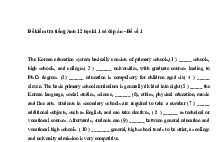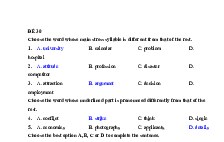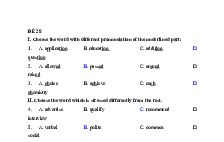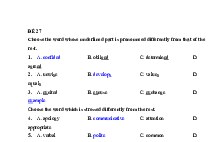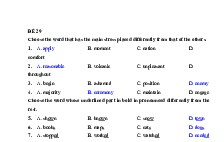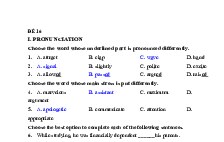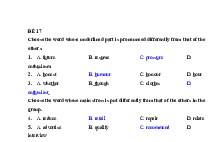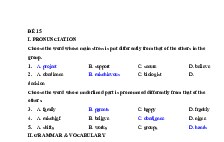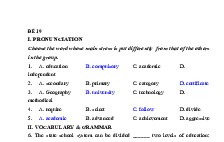6. Đề thi thử TN THPT 2021 - Môn Tiếng Anh - Bộ đề chuẩn cấu trúc minh họa - Đề 6 - File word có lời giải.
Nội dung tài liệu
Tải xuống
Link tài liệu:
Các tài liệu liên quan
-
![Đề thi học kì 1 Tiếng anh lớp 12 năm 2020-2021 ĐỀ SỐ 2]()
-
![Đề thi học kì 1 Tiếng anh lớp 12 năm 2020-2021 ĐỀ SỐ 1]()
-
![Đề thi học kì 1 Tiếng anh lớp 12 năm 2020-2021 ĐỀ SỐ 30]()
-
![Đề thi học kì 1 Tiếng anh lớp 12 năm 2020-2021 ĐỀ SỐ 28]()
-
![Đề thi học kì 1 Tiếng anh lớp 12 năm 2020-2021 ĐỀ SỐ 27]()
-
![Đề thi học kì 1 Tiếng anh lớp 12 năm 2020-2021 ĐỀ SỐ 29]()
-
![Đề thi học kì 1 Tiếng anh lớp 12 năm 2020-2021 ĐỀ SỐ 16]()
-
![Đề thi học kì 1 Tiếng anh lớp 12 năm 2020-2021 ĐỀ SỐ 17]()
-
![Đề thi học kì 1 Tiếng anh lớp 12 năm 2020-2021 ĐỀ SỐ 15]()
-
![Đề thi học kì 1 Tiếng anh lớp 12 năm 2020-2021 ĐỀ SỐ 14]()
Có thể bạn quan tâm
Thông tin tài liệu
SỞ GIÁO DỤC VÀ ĐÀO TẠO
ĐỀ CHUẨN MINH HỌA 06
(Đề thi có 04 trang)
KỲ THI TỐT NGHIỆP TRUNG HỌC PHỔ THÔNG NĂM 2021
Bài thi: NGOẠI NGỮ; Môn thi: TIẾNG ANH
Thời gian làm bài: 60 phút không kể thời gian phát đề
-------------------------Họ, tên thí sinh:…………………………………………………………………………
Số báo danh:....................................................................................................................
Mark the letter A, B, C, or D on your answer sheet to indicate the word whose underlined part differs from
Question 1. A. cleaned
B. played
C. snowed
D. brushed
Question 2. A. spoon
B. flood
C.food
D. soon
Mark the letter A, B, C, or D on your answer sheet to indicate the word that differs from the other three in
the position of primary stress in each of the following questions.
Question 3. A. culture
B. nature
C. mature
D. vulture
Question 4. A. fortunate
B. genuine
C. accelerate
D. genocide
Mark the letter A, B, C, or D on your answer sheet to indicate the correct answer to each of the following
questions.
Question 5. I’m getting better at this job,______?
A. am I
B. am not I
C. isn’t I
D. aren’t I
Question 6. We can’t go along here because the road........................
A. is repairing
B. is repaired
C. is being repaired
D. repairs
Question 7. When asked about their preference for movies, many young people say that they are in favor
science fiction.
A. for
B. of
C. in
D. with
Question 8. Air pollution is getting
serious in big cities in the world.
A. more and more
B. the more and the more
C. the most and the most
D. most and most
Question 9. . On my birthday, my mother gave me a
.
A. new blue German car B. blue German new car C. new German blue car D. German new blue car
Question 10: He fell down when he
towards the church.
A. run
B. runs
C. was running
D. had run
Question 11: He always did well at school_________having his early education disrupted by illness.
A. Because of
B. because
C. though
D. in spite of
Question 12: ________to my country, I will have been away from home for more than three years.
A. By the time I returned
B. By the time I return
C. When I return
D. Only when I return
Question 13:
for 4 hours, they decided to stop to have lunch at a cheap restaurant.
A. Having been walked
B. Having walked
C. Walking
D. Walked
Question 14: Her family and friends have given her lots of
A. supports
B. support
C. supporters
D. supportive
Question 15: The trouble with James is that he never
on time for a meeting.
A. turns up
B. takes off
C. takes up
D. turns down
Question 16: The course was so difficult that I didn’t
any progress at all.
A. do
B. make
C. produce
D. create
Question 17: Peter has a separate room for his musical .
A. instruments
B. equipment
C. tools
D. facilities
Question 18: The human criterion for perfect vision is 20/20 for reading the standard lines on a Snellen eye
chart without
.
A. a hitch
B. glasses
C. little
D. method
Question 19: You’re putting the cart before the
of you work on Project B before Project A because
the former is a sequel to the latter.
A. horse
B. dog
C. buffalo
D. ox
Mark the letter A, B, C, or D on your answer sheet to indicate the word(s) CLOSEST in meaning to the un derlined word(s) in each of the following questions.
Question 20: Her style of dress accentuated her extreme slenderness.
A. betrayed
B. emphasized
C. revealed
D. disfigured
Question 21: Shopping on the internet can be safe if you follow a few simple rules.
A. uncomplicated
B. unimportant
C. unlucky
D. unsociable
Mark the letter A, B, C, or D on your answer sheet to indicate the word(s) OPPOSITE in meaning to the
underlined word(s) in each of the following questions.
Question 22: She decided to remain celibate and devote her life to helping the homeless and orphans.
A. divorced
B. separated
C. single
D. married
Question 23: Driver are advised to get enough petrol because filling stations are few and far between on the
highway.
A. unlikely to happen
B. difficult to access
C. easy to find
D. impossible to reach
Mark the letter A, B, C, or D on your answer sheet to indicate the option that best completes each of the following exchanges.
Question 24: - “Would you like some more chicken?” - “______ I’m full”.
A. Yes, please.
B. No, thanks.
C. Yes, I would.
D. No, I wouldn’t.
Question 25: - “Do you think they will fail in the examination?” - “No, ______”
A. I hope they will.
B. I don’t think so.
C. I don’t hope.
D. I don’t think.
Read the following passage and mark the letter A, B, C, or D on your answer sheet to indicate the correct
word or phrase that best fits each of the numbered blanks from 26 to 30.
Those who work at home may find that the solitude can be a double-edged sword. It is, of course, easier to
(26) ______ when you're in your own home with no co-workers coming by your desk to chat at random times.
But while this solitude can feel blissful at times, when we have no mandate for social interaction during the
workday—when we don't automatically run across people outside of those we live with—we can become lonely
before we realize it.
Social media can feel like a lifeline to others, but this type of (27) ______ can sometimes feel isolating as
well, as these interactions can feel less personal than face-to-face encounters and conversations. (28) ______ we
may not need to resort to painting a face on a volleyball and talking to it, the feelings of isolation can sneak up
and we can feel (29) ______ alone than we expect. And given the research on loneliness, this doesn't always
feel good. Social isolation was a factor mentioned in the UN study (30) ______ was related to increased stress
of home-based workers.
(Adapted from https://www.verywellmind.com/)
Question 26: A. relax
B. focus
C. protect
D. continue
Question 27: A. introduction B. marketing
C. community
D. interaction
Question 28: A. While
B. Unless
C. Because
D. Despite
Question 29: A. few
B. less
C. a few
D. more
Question 30: A. where
B. whom
C. that
D. who
Read the following passage and mark the letter A, B, C, or D on your answer sheet to indicate the correct
answer to each of the questions from 31 to 35.
Who talk more men or women? Most people believe that women talk more. However, linguist
Deborah Tannen, who has studied the communication style of men and women, says that this is a stereotype.
According to Tannen, women are more verbal - talk more in private situations, where they use conversation as
the “glue” to hold relationships together. But, she says, men talk more in public situations, where they use
conversation to exchange information and gain status. Tannen points out that we can see these differences even
in children. Little girls often play with one "best friend", their play includes a lot of conversation. Little boys
often play games in groups; their play usually involves more doing than talking. In school, girls are often better
at verbal skills, boys are often better at mathematics.
A recent study at Emory University helps to shed light on the roots of this difference. Researchers
studied conversations between children aged 3-6 and their parents. They found evidence that parents talk
very differently to their sons than they do to their daughters. The startling conclusion was that parents use more
language with their girls. Specifically, when parents talk with their daughters, they use more
descriptive language and more details. There is also far more talk about emotions, especially with daughters
than with sons.
Question 31: Which sentence best expresses the main idea of the first paragraph?
A. Little girls and little boys have different ways of playing.
B. Women talk more than men on the whole.
C. It's a stereotype that women talk more than men.
D. Women talk more in private, and men talk more in public.
Question 32: The word "they" in the first paragraph refers to ___________.
A. situations
B. men and women
C. men
D. women
Question 33: Which of the following statements is TRUE according to the passage?
A. Parents use more language to talk with their daughters.
B. Parents give more love to their daughters than their sons.
C. Boys don't like showing their emotions.
D. Boy's play usually involves more talking than doing.
Question 34: Which word could best replace "startling" in the second paragraph?
A. beginning
B. annoying
C. interesting
D. surprising
Question 35: Which of the following statements is NOT true, according to the passage?
A. Women use conversation as the "glue" to hold relationships together.
B. One little girl often plays with many of her best friends.
C. Parents talk to their sons and their daughters very differently.
D. Men use conversation to exchange information and gain status.
Read the following passage and mark the letter A, B, C, or D on your answer sheet to indicate the correct
answer for each of the blanks.
Scientists believe they now have scientific evidence to prove that ecosystems work better when there is
a greater variety of species within them. This biodiversity is being lost destroying natural mechanisms
that could repair the damage caused by man.
Findings show that losing plants and animals is not only reducing our quality of life but
actually endangering our very existence. We cut down rich rainforests and replace them with one species
plantations, such as pine and eucalyptus. We plough up meadows rich in different grasses and herbs and replace
them with one grass, for instance rye or wheat.
When a natural ecosystem is simplified the basic processes in the ecosystem are altered and
even damaged. Without their biodiversity, they are not able to serve as the natural cleaners of our planet. No
longer are they able to absorb the carbon dioxide that is being produced in excess. The result is
global warming, caused by the increase in the 'greenhouse effect', and ultimately, or even sooner, there will be
a change in the world's climate.
Question 36: Which of the following is the best title for the passage?
A. How Ecosystems Work Better
B. The Loss of Biodiversity
C. The Variety of Species
D. Natural Mechanisms
Question 37: Which of the following is not a species used to replace a rich ecosystem?
A. Herbs
B. Pine
C. Eucalyptus
D. Rye
Question 38: What is the purpose of paragraph 2?
A. To show natural mechanisms at work.
B. To give examples of the loss of biodiversity
C. To give example of variety of species.
D. To show how ecosystems can work better.
Question 39: What, according to the passage, might be the final result of the simplification of
natural ecosystems?
A. The basic processes are altered
B. There is a loss of biodiversity
C. There is global warming
D. There is a change in the climate.
Question 40: The word "them" in paragraph 2 refers to __________.
A. Animals
B. Plants
C. rain forests
D. species
Question 41: The word "Findings" in paragraph 2 is closest in meaning to ______.
A. Expressions
B. Information
C. Inventions
D. Excavation
Question 42: As used in paragraph 3, the word “absorb” could be beat replaced which of the following?
A. take in
B. draw back
C. get rid of
D. pay back
Mark the letter A, B, C or D to indicate the underlined part that needs correction in each of the following
questions.
Question 43: Caroline has worn her new yellow dress only once since she buys it.
A
B
C
D
Question 44. The puppy stood up slowly, wagged their tail, blinked its eyes, and barked.
A
B
C
D
Question 45: Many successful film directions are former actors who desire to expand their experience in the
A
B
C
D
film industry.
Mark the letter A, B, C, or D to indicate the sentence that is closest in meaning to each of the following
questions.
Question 46: The last time I saw her was three years ago.
A. I have not seen her for three years.
B. About three years ago, I used to meet her.
C. I have often seen her for the last three years.
D. I saw her three years ago and will never meet her
Question 47. “Would you like to come out to dinner with me tonight, Jenny?” Paul said.
A. Paul suggested that Jenny go out to dinner with him that night.
B. Paul insisted on Jenny going out to dinner with him that night.
C. Paul invited Jenny to go out to dinner with him that night.
D. Pau offered Jenny to go out to dinner with him that night
Question 48. I’m sure that they had practiced hard for the games as they won a lot of medals.
A. They couldn’t have practiced hard for the games as they won a lot of medals
B. They must have practiced hard for the games as they won a lot of medals
C. They shouldn’t have practiced hard for the games as they won a lot of medals
D. They might have practiced hard for the games as they won a lot of medals.
Mark the letter A, B, C, or D to indicate the sentence that best combines each pair of sentences in the
following questions.
Question 49: : I really regret that you haven't told me about her family.
A. If only you would tell me about her family.
B. If only I didn't regret that you hadn't told me about her family.
C. If only you had told me about her family.
D. If only you hadn't told me about her family.
Question 50: John didn’t understand what the story was about until he saw the film based on it.
A. He doesn't understand what the story is about.
B. Not until Jonh saw the film based on the story did he understand what it was about.
C. It was until he saw the film based on it that John understood what the story was about.
D. John went to see the film before she read the story.
HƯỚNG DẪN GIẢI CHI TIẾT
Question 1. D.
Giải thích:
A. cleaned /kliːnd/
B. played /pleɪd/
C. snowed /snəʊd/
D. brushed /brʌʃt/
Các đáp án A, B, C có “ed” được phát âm là /d/. Đáp án D có “ed” được phát âm là /t/.
Question 2. B.
Giải thích:
A. spoon /spuːn/
B. flood /flʌd/
C. food /fuːd/
D. soon /suːn/
Các đáp án A, C, D có “oo” được phát âm là /uː/. Đáp án B có "oo” được phát âm là /ʌ/.
Question 3. C
Giải thích: Trọng âm rơi âm số 2, còn lại là âm số 1
A. /ˈkʌltʃə[r]/
B. /ˈneitʃə[r]/
C. /məˈtʃʊə[r]/
D. /ˈvʌltʃə[r]/
Question 4. C
Giải thích: Trọng âm rơi âm số 2, còn lại nhấn âm số
A. /ˈfɔːtʃənət/
B. /ˈdʒenjuɪn/
C. /əkˈseləreɪt/
D. /ˈdʒenəsaɪd/
Question 5. D
Kiến thức: Câu hỏi đuôi . Cấu trúc: S+ be + O, not be ?
Giải thích : Câu bắt đầu với I’m thì thành lập đuôi câu hỏi sẽ dung aren’t =>chọn D
Tạm dịch: Tớ đang dần thạo công việc này hơn rồi , phải không?
Question 6: C
Phương pháp giải:
Kiến thức: Câu bị động:
Giải chi tiết: Câu bị động thì Hiện tại tiếp diễn. Hành động được nhấn mạnh đang được sửa chữa .
S + động từ tobe + being+ V-ed/V3
Tạm dịch : Chúng ta không đi dọc theo lối này được bởi vì đường đi đang được sửa chữa..
Question 7. B
Cấu trúc “ in favor of”: ủng hộ cho..
Đáp án B
Tạm dịch: Khi được hỏi về sở thích phim ảnh, rất nhiều người trẻ ủng hộ cho tiểu thuyết khoa
học viễn tưởng
Question 8. A
Dịch: Ô nhiễm không khí càng ngày càng nghiêm trọng tại các thành phố lớn trên thế giới.
(so sánh tăng tiến: more and more + ADJ = càng ngày càng…)
Question 9. A
Trật tự của các tính từ trước danh từ: OpSACOMP
Size Age Origin Purpose Opinion - tính từ chỉ quan điểm (beautiful, wonderful, bad...)
Size - tính từ chỉ kích cỡ (big, small, long, big, short, tall...) Age - tính từ chỉ độ tuổi (old, young, new...)
Color - tính từ chỉ màu sắc (orange, yellow, blue ...)
Origin - tính từ chỉ nguồn gốc, xuất xứ (Japanese, American, Vietnamese...) Material - tính từ chỉ chất liệu,
(stone, plastic, leather, silk...)
Purpose - tính từ chỉ mục đích, tác dụng
Do đó, trật tự của tính từ trong câu này là new (age) - blue (color) - German (origin)
Question 10: C
“When” dùng để diễn tả 1 hành động đang xảy ra 1 hành động khác xen vào
Thì quá khứ tiếp diễn
Đáp án C
Tạm dịch: Anh ấy bị ngã khi chạy về phía nhà thờ
Question 11: D
Kiến thức: Liên từ / Mệnh đề nhượng bộ
Giải thích:
Dấu hiệu: sau chỗ trống là một cụm danh từ “his disability”.
A. because of + N/V-ing: bởi vì
B. because + S + V: bởi vì => loại
C. though + S + V: mặc dù => loại
D. in spite of + N/V-ing: mặc cho, mặc dù
Xét về nghĩa câu => D phù hợp nhất.
Tạm dịch:
Chọn D
Question 12: B
Kiến thức: Mệnh đề thời gian
Giải thích: Công thức: By the time S + V (hiện tại đơn), S + will have P2
Tạm dịch: Khi tôi quay trở lại quê hương, tôi sẽ đã xa nhà hơn 3 năm rồi.
Question 13: B
Kiến thức về phân từ hoàn thành
Phân từ hoàn thành (Having + Vp2) dùng để nhấn mạnh một hành động đã xảy ra xong rồi mới tới hành
động khác.
Tạm dịch: Đi bộ được 4 tiếng, họ quyết định dừng lại để ăn trưa tại một nhà hàng giá rẻ.
Question 14: B
Kiến thức về từ loại
Sau “lots of” cần kết hợp với 1 danh từ
A, B, C đều là danh từ nên loại D vì là tính từ Loại C vì cần danh từ chỉ vật
Loại A vì “support” là danh từ không đếm được
=> Đáp án B
Tạm dịch: Gia đình và bạn bè của cô ấy ủng hộ cô ấy rất nhiều.
Question 15: A
Kiến thức về cụm động từ cơ bản
Turn up: đến, xuất hiện
Take off: cởi
Take up: bắt đầu (1 sở thích) Turn down: vặn nhỏ (âm lượng) Dựa vào ngữ nghĩa → chọn A
Dịch: Vấn đề với James là cậu ấy không bao giờ đến đúng giờ trong một buổi họp.
Question 16: B
Kiến thức về sự kết hợp từ
Make progress ~ improve: tiến bộ.
Dịch: Khóa học này quá khó đến nỗi tôi không tiến bộ lên được chút nào.
Question 17: A
musical instrument: nhạc cụ
equipment (n): trang thiết bị cần cho một hoạt động cụ thể
tool (n): công cụ như búa, rìu,… cầm bằng tay để tạo ra hoặc sửa đồ vật
facility (n): cơ sở vật chất (công trình xây dựng, trang thiết bị,…) phục vụ cho mục đích cụ thể Tạm dịch: Peter
có một phòng riêng cho các nhạc cụ của anh ấy.
=> Đáp án A
Question 18: A
Kiến thức về thành ngữ
Without a hitch: Không có khó khăn
Tạm dịch
Tiêu chí của con người đối với thị lực hoàn hảo là 20/20 đối với việc đọc các đường chuẩn trên biểu đồ mắt
Snellen. mà không gặp trở ngại.
Question 19: A
Idiom: “put the cart before the horse”: cầm đèn chạy trước ô tô
Tạm dịch: Bạn đang cầm đèn chạy trước ô tô khi bạn làm dự án B trước dự án A vì dự án B là tiếp nối sau
dự án A
Mark the letter A, B, C, or D on your answer sheet to indicate the word(s) CLOSEST in meaning to the un derlined word(s) in each of the following questions.
Question 20: B
Giải thích: Her style of dress accentuated her extreme slenderness.
(Phong cách ăn mặc của cô ấy làm nổi bật sự thon thả cực độ của cô.)
A. betrayed (v.): phản bội
B. emphasized
(v.): nhấn mạnh
C. revealed (v.): tiết lộ
D. disfigured
(v.): làm biến dạng
Vậy accentuated có nghĩa tương đồng với phương án B.
Question 21: A
Giải thích: Shopping on the internet can be safe if you follow a few
simple rules. (Mua sắm trên internet có thể an toàn nếu bạn tuân theo
một vài quy tắc đơn giản.)
A. uncomplicated (adj.): không phức tạp
B.
unimportant (adj.): không quan trọng
C. unlucky (adj.): không may mắn
(adj.): không hay giao du
Vậy simple có nghĩa tương đồng với phương án A.
Mark the letter A, B, C, or D on your answer sheet to indicate the word(s) OPPOSITE in meaning to the
underlined word(s) in each of the following questions.
Question 22: D
Giải thích: She decided to remain celibate and devote her life to helping
the homeless and orphans. (Cô quyết định sống độc thân và cống hiến cả
cuộc đời để giúp đỡ những người vô gia cư và trẻ mồ côi.)
A. divorced (adj.): li hôn
B.
separated
(adj.): li thân
C. single (adj.): độc thân
D.
married
(adj.): đã kết hôn
Vậy celibate có nghĩa tương phản với phương án D.
Question 23: C
Giải thích: Driver are advised to get enough petrol because filling
stations are few and far between on the highway. (Tài xế được khuyên
nên đổ đủ xăng vì các trạm đổ xăng rất ít và xa giữa đường cao tốc.)
A. unlikely to happen: không xẩy ra
access: khó tiếp cận
C. easy to find
: dễ tìm
D. impossible to reach: không thể đến
Vậy few and far between có nghĩa tương phản với phương án C.
Mark the letter A, B, C, or D on your answer sheet to indicate the option that best completes each of the following exchanges.
Question 24: B
Giải thích: Lời đáp cần đưa ra câu trả lời phủ định phù hợp, lịch sự khi
được mời ăn thêm.
A. Vâng, tôi muốn.
B. Không, cảm ơn.
C. Vâng, tôi muốn.
D. Không, tôi không muốn.
Dịch nghĩa: “Bạn có muốn ăn thêm thịt gà không?” – “Không, cám
ơn. Tôi no rồi.”
Question 25: B
Giải thích: Lời đáp cần đưa ra ý phủ định phù hợp.
A. Tôi hy vọng họ sẽ trượt.
không nghĩ như vậy.
C. Tôi không hy vọng.
không suy nghĩ.
Dịch nghĩa: “Bạn có nghĩ rằng họ sẽ thất bại trong kỳ thi không?” –
“Không, tôi không nghĩ như vậy.”
Read the following passage and mark the letter A, B, C, or D on your answer sheet to indicate the correct
word or phrase that best fits each of the numbered blanks from 26 to 30.
Question 26: B
Giải thích: Phương án B phù hợp về nghĩa.
A. relax (v.): thư giãn
B. focus (v.): tập trung
C. protect (v.): bảo vệ
D. continue (v.): tiếp tục
Question 27: D
Giải thích: Phương án D phù hợp về nghĩa.
A. introduction (n.): giới thiệu
B.
marketing (n.): tiếp thị
C. community (n.): cộng đồng
D.
interaction (n.): tương tác
Question 28: A
Giải thích: Sau chỗ trống là mệnh đề nên cần điền liên từ. Phương án A
phù hợp về nghĩa.
Question 29: D
Giải thích: Phương án D phù hợp về nghĩa và ngữ pháp.
Question 30: C
Giải thích: Đại từ quan hệ “that” thay thế cho sự vật “UN study”, các
đại từ khác không có chức năng này.
Dịch nghĩa toàn bài:
Những người làm việc tại nhà có thể thấy rằng sự riêng tư có thể là con dao hai lưỡi. Tất nhiên, sẽ dễ tập
trung hơn khi bạn ở trong chính ngôi nhà của mình mà không có đồng nghiệp nào đến cạnh bàn để trò chuyện
vào những thời điểm ngẫu nhiên. Nhưng trong khi sự riêng tư này nhiều lúc có thể khiến bạn cảm thấy hạnh
phúc, khi chúng ta không có sự bắt buộc phải giao tiếp xã hội trong ngày làm việc, khi chúng ta không tình cờ
gặp ai ngoài những người chúng ta sống cùng, chúng ta có thể trở nên cô đơn trước khi nhận ra điều đó.
Phương tiện truyền thông xã hội dường như là rất quan trọng đối với những người khác, nhưng loại tương
tác này đôi khi cũng có thể cảm thấy bị cô lập, vì những tương tác này có thể cảm thấy ít cá nhân hơn so với các
cuộc gặp gỡ và trò chuyện trực tiếp. Mặc dù chúng ta có thể không cần phải vẽ hình mặt người lên một quả
bóng chuyền và nói chuyện với nó nhưng cảm giác bị cô lập có thể diễn ra âm thầm và chúng ta có thể cảm thấy
cô đơn hơn chúng ta nghĩ. Và đưa ra nghiên cứu về sự cô đơn, điều này không phải lúc nào cũng cảm thấy tốt.
Sự cô lập xã hội là một yếu tố được đề cập trong nghiên cứu của Liên Hợp Quốc có liên quan đến sự căng thẳng
gia tăng của những người làm việc tại nhà.
Question 31 (VD)
Kiến thức: Đọc hiểu – ý chính
Giải thích:
Câu nào thể hiện rõ nhất ý chính của đoạn đầu?
A. Các cô bé và cậu bé có những cách chơi khác nhau.
B. Về tổng thể, phụ nữ nói nhiều hơn nam giới.
C. Đó là một định kiến cho rằng phụ nữ nói nhiều hơn nam giới.
D. Phụ nữ nói nhiều hơn ở nơi riêng tư và nam giới nói nhiều hơn ở nơi công cộng.
Thông tin:
- women are more verbal - talk more in private situations,
- men talk more in public situations,
- Little girls often play with one "best friend", their play includes a lot of conversation.
Tạm dịch:



